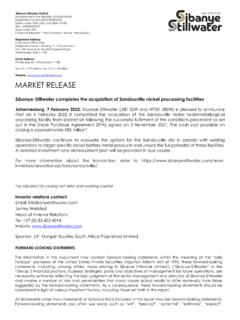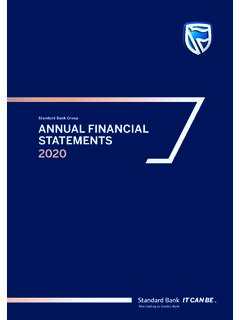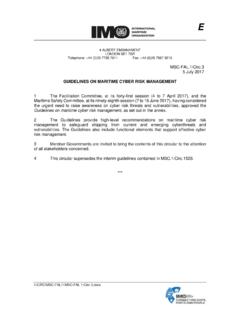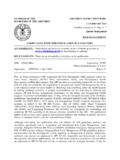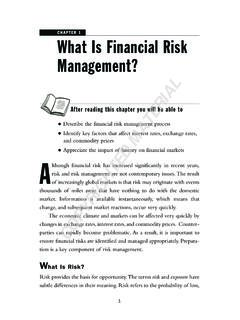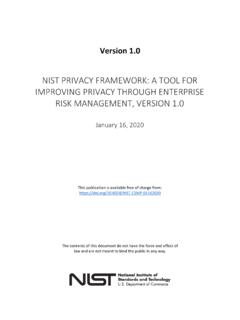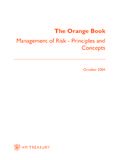Transcription of Risk management report - The Vault
1 1 Standard Bank Group risk management report for the six months ended June 2010 Risk managementreportfor the six months ended 30 June management Bank Group risk management report for the six months ended June 2010 Risk managementtough economic environment. Executive management remained closely involved in important risk management initiatives, which have focused particularly on preserving appropriate levels of liquidity and capital, and effectively managing the risk portfolios. Responsibility and accountability for risk management resides at all levels within the group, from the board down through the organisation to each business manager and risk specialist.
2 risks are controlled at the level of individual exposures and at portfolio level, as well as in aggregate across all businesses and risk Focus areas for 2010 In our 2009 annual report we set out specific risk focus areas for 2010. We continue to make good progress on these initiatives. The group continues to focus significant attention on the proposed changes to Basel II, and to this end we participated in the Comprehensive Impact Assessment as well as industry groups at a local and global Introduction Effective risk management is fundamental to the business activities of the group. While we remain committed to increasing shareholder value by developing and growing our business within our board-determined risk appetite, we are mindful of achieving this objective in line with the interests of all stakeholders.
3 We seek to achieve an appropriate balance between risk and reward in our business, and continue to build and enhance the risk management capabilities that assist in delivering our growth plans in a controlled environment. Risk management is at the core of the operating structure of the group. We seek to limit adverse variations in earnings and capital by managing risk exposures within agreed levels of risk appetite. Our risk management approach includes minimising undue concentrations of exposure, limiting potential losses from stress events and ensuring the continued adequacy of all our financial resources. Our risk management processes have continued to prove effective throughout the first half of 2010, despite a The group uses the three lines of defence model: First line of defenceBusiness unit managementPrimarily responsible for risk management .
4 The process of assessing, evaluating and measuring risk is ongoing and is integrated into the day-to-day activities of the business. This process includes implementing the group s risk management framework, identifying issues and taking remedial action where required. Business unit management is also accountable for reporting to the governance bodies within the line of defenceGroup and business unit risk management functions which are appropriately independent of business managementThe group risk management function is primarily accountable for setting the group s risk management framework and policy, providing oversight and independent reporting to executive management through the group risk oversight committee, and to the board through the group credit committee and the group risk and capital management committee.
5 The business unit risk management functions implement the group s risks management framework and policy in the business units, approve risk within specific mandates and provide an independent overview of the effectiveness of risk management by the first line of line of defenceInternal audit functionProvides an independent assessment of the adequacy and effectiveness of the overall risk management framework and risk governance structures, and reports to the board through the group audit Bank Group risk management report for the six months ended June 2010 Various committees allow executive management and the board to evaluate the risks faced by the group, as well as the effectiveness of the group s management of these risks .
6 These committees are integral to the group s risk governance structure. The senior committees are set out in figure 1. approving and monitoring the group s risk profile and risk tendency against risk appetite for each risk type under normal and potential stress conditions. Executive management oversight for all risk types at group level has been delegated by the group executive committee to the group risk oversight committee (GROC). This committee considers and, to the extent required, recommends for approval by the relevant board committees: levels of risk appetite and tolerance; risk governance standards for each risk type; actions on the risk profile; risk strategy and key risk controls across the group; capital planning and capital funding activities; utilisation of risk appetite; and usage and allocation of economic capital parameters for modelling, stress testing and scenario Risk management Governance structure Strong independent oversight is in place at all levels throughout the group.
7 The group audit committee (GAC) is responsible for: reviewing the group s financial position and making recommendations to the board on all financial matters, including assessing the integrity and effectiveness of accounting, financial, compliance and other control systems; and ensuring effective communication between internal auditors, external auditors, the board, management and regulators. The group risk and capital management committee (GRCMC) and the group credit committee (GCC) provide, among other things, independent and objective oversight of risk and capital management across the group by: reviewing and providing oversight of the adequacy and effectiveness of the group s risk management control framework; approving risk and capital management governance standards and policies.
8 AndFigure 1: Governance reporting structureStandard BankGroup boardManagement committeesBoard committeesGroup executivecommitteeGroup risk oversightcommitteeGroup auditcommitteeGroup creditcommitteeGroup risk andcapital managementcommitteeSBSA large exposurecredit committeeIntragroupexposurecommitteeGrou p riskcompliancecommitteeGroup capitalmanagementcommitteeGroup assetand liabilitycommitteeGroupoperational riskcommitteeGroupcountry riskmanagementcommitteeTransaction review committeeGlobal Personal& BusinessBanking creditcommittee1 Global Corporate& InvestmentBanking creditcommittee11 The board has delegated authority to these
9 Committees to act as nominated designated committees in respect of the Bank Group risk management report for the six months ended June 2010 Risk management continued Compliance with risk standards is controlled through annual self-assessments conducted by business units and group risk and review independently by the group internal Risk appetite Risk appetite is the maximum level of residual risk that the group is prepared to accept to deliver its business objectives. The group has developed a robust framework that is used to articulate risk appetite throughout the group and to external stakeholders. The board establishes the group s parameters for risk appetite by: providing strategic leadership and guidance; reviewing and approving annual budgets and forecasts, under both normal and stressed conditions, for the group and each division; and regularly reviewing and monitoring the group s risk performance through quarterly board reports.
10 The board delegates the determination of risk appetite to the GRCMC and ensures that risk appetite is in line with group strategy and the group s desired balance between risk and reward. GROC recommends to both the GRCMC and the board the level of risk appetite for the group. The group s risk appetite statements are defined by five broad metrics: headline earnings; liquidity; regulatory capital; economic capital; and the confidence level applied to our capital adequacy to cover any unexpected losses. These metrics are then converted into tolerance levels and limits through an analysis of the risks that impact on Stress testing The group s stress testing framework guides the regular execution of stress tests at the business unit, legal entity and group levels.

